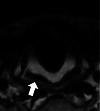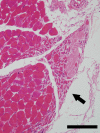Histopathological Features of Gerhardt Syndrome in a Patient With Multiple System Atrophy: An Autopsy Case Report
- PMID: 36407156
- PMCID: PMC9669818
- DOI: 10.7759/cureus.30415
Histopathological Features of Gerhardt Syndrome in a Patient With Multiple System Atrophy: An Autopsy Case Report
Abstract
Multiple system atrophy (MSA) is a progressive neurodegenerative disease characterized by autonomic failure, parkinsonism, and cerebellar ataxia. Gerhardt syndrome, which is inspiratory dyspnea with laryngeal stridor associated with dysfunction of the vocal folds, is a frequent and fatal complication of MSA. A 59-year-old man with a six-year history of MSA presented with ataxia and dysarthria. He also had dyspnea and stridor, which had worsened in the last three months, and died from respiratory distress. Autopsy revealed neurogenic group atrophy of the posterior cricoarytenoid (PCA) muscle, which suggested that laryngeal nerve damage caused abductor vocal fold paralysis in addition to cerebellar and brainstem atrophy with glial cytoplasmic inclusions. Our histopathological findings suggest that Gerhardt syndrome may be associated with neurogenic atrophy of the laryngeal abductor muscle (PCA muscle) of the vocal folds.
Keywords: gerhardt syndrome; group atrophy; multiple system atrophy; pathological autopsy; posterior cricoarytenoid muscle.
Copyright © 2022, Nakahara et al.
Conflict of interest statement
The authors have declared that no competing interests exist.
Figures



References
Publication types
LinkOut - more resources
Full Text Sources
